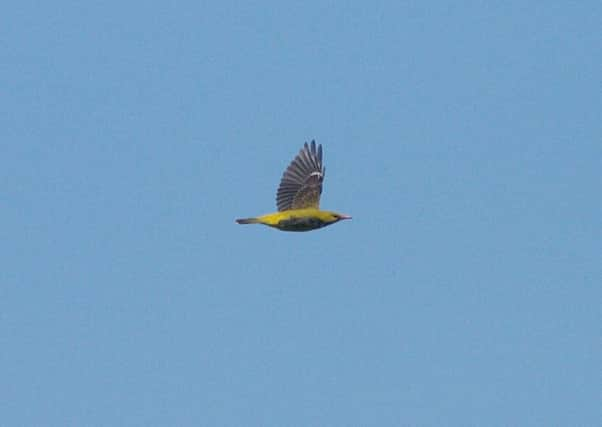Birdwatch: Chance to see golden visitor on edge of its range


But there have been plenty of opportunities to see one at Spurn this week with an immature male both in flight and singing from bushes along the Canal Path, Beacon Lane and near the Observatory.
The adult male is among the most brilliantly coloured of our summer visitors, a combination of banana yellow and black wings and tail. Females and immature birds are a greenish yellow and, with their undulating flight and similar size, can easily be confused with green woodpeckers.
Advertisement
Hide AdAdvertisement
Hide AdFor such a brightly coloured bird the golden oriole is surprisingly hard to see in trees. I once watched one fly to the edge of a wood in Cyprus and then virtually disappear - a combination of bright sunlight, shade and trembling leaves created a pattern of black and yellow that blended perfectly with its plumage.
Golden orioles start to return from Africa in May and continue into this month.
Britain is at the extreme western edge of their range and they are a comparatively recent addition to the list of birds that breed here. Nesting pairs were first discovered in East Anglia in the 1960s with the population reaching a peak of 40 singing males in 1979.
The favoured habitat is almost always in stands of hybrid black poplar trees first planted by the firm of Bryant and May to provide wood for matches and pallets.
Advertisement
Hide AdAdvertisement
Hide AdIn the 1980s the firm moved production abroad and many of these plantations were felled. But the RSPB, Golden Oriole Group, Natural England and the Suffolk Wildlife Trust intervened to save part of one plantation at Lakenheath on the Norfolk, Suffolk border which now forms part of the RSPB’s Lakenheath Fen reserve.
Golden orioles are still found there and the RSPB is planting more black poplars and encouraging nearby landowners to do so too, to try and ensure their continued return. The golden oriole’s range seems to be moving eastwards in Europe and it could be that it will disappear as a breeding species here before much longer.
Another brightly coloured visitor, a bee-eater, was seen at Spurn while other sightings included a female red-footed falcon and woodlark. There are now some 80 little terns back at Yorkshire’s only colony at Beacon Ponds and a new warden, Daniel Branch, is keeping watch over them. More volunteers are needed to help him. For more details contact Paul Collins on 01904 650479 or [email protected]
A little tern was seen inland at Swillington Ings, Leeds and sandwich terns at the North Cave Wetland, East Yorkshire and Southfield reservoir.
Advertisement
Hide AdAdvertisement
Hide AdA drake common scoter was on the Kilnsea wetland, 20 inland at Swillington Ings and one at Angler’s Country Park.
The little bittern continued to draw people to the Old Moor reserve near Barnsley and it also visited Bolton Ings.
Meanwhile four juvenile bitterns have been seen on the reserve, and a hoopoe was reported at Tickhill near Rotherham.